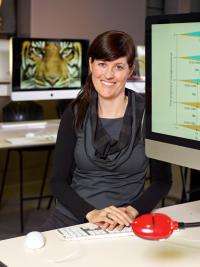Can we save the tiger with mathematics?

Turning to mathematics to allow us to make smarter conservation decisions.
The diversity of life on Earth underpins the global economy. But we’re losing biodiversity at an unprecedented rate and human-induced climate change will threaten more species—up to 37 per cent of the plants and animals with which we share the world.
Dr. Eve McDonald-Madden is doing something about it. She’s recognised that, despite the urgency of the problem, the funds and resources to tackle the problem are limited. So she’s turned to mathematics to develop systems that allow us to make smarter conservation decisions.
Working at The University of Queensland and CSIRO, she has already helped to develop and implement a policy for monitoring the Sumatran tiger to prevent poaching. In addition, she has come up with a strategy for managing Tasmanian devils as they confront an infectious facial tumour disease.
In short, Eve McDonald-Madden has become a world expert on making effective conservation decisions when information is limited.
Her achievements have won her a $20,000 L’Oréal Australia For Women in Science Fellowship and, with its assistance, she will travel to France with her young son to learn about and incorporate the latest techniques of artificial intelligence (AI) into her decision-making frameworks.
Off to a flying start
Flying foxes helped Eve McDonald-Madden recognize what she wanted to do with her life. She was studying the foraging behaviour of grey-headed flying foxes as a team leader at Victoria’s Arthur Rylah Institute of Environmental Research.
The flying foxes had become a real problem. Tens of thousands of them had made their home in Melbourne’s iconic Botanic Gardens. They were beginning to overburden and ruin the important collection of trees and other plants. As a native species, they couldn’t simply be exterminated. Decisions as to how to handle them had to be made as quickly as possible, and data was limited.
“It opened my eyes as to what you really needed to know to aid conservation,” Eve says. “And that basically boiled down to numbers—being quantitative—and being able to use what data you had to come up with good decisions.”
“But I also realized there were limitations in people’s understanding of quantitative approaches—not only in knowing how much information they needed, but what techniques they could use to analyse and get the most out of the information they had.”
As she came to her realisation of the importance of structured decision-making based on sophisticated data analysis, Eve also recognised that she needed to improve her skills. So, while working full-time, she enrolled in a Diploma of Mathematics and Statistics via distance education at the University of New England. And, in the process of educating herself, Eve discovered a love of maths.
The next step was to get involved in learning about and generating improved environmental decision-making tools, and the most obvious way to achieve that was to do a PhD. But who should be her supervisor? Asking around, the field quickly narrowed to one person, Prof Hugh Possingham at The University of Queensland, who holds a joint chair in biological sciences and mathematics.
Eve began work with him in 2005 and has been with him ever since. Eve is now a chief investigator in two research centres of which he is director—the ARC Centre for Excellence in Environmental Decisions and the National Environmental Research Program Environmental Decisions Hub. She also works one day a week at CSIRO Ecosystem Sciences.
“We can’t delay decisions until we have enough data to make the best management decisions. My research focuses on helping make better conservation decisions faster by analysing the trade-offs between available dollars, our need for information, and the urgency of the conservation issue at hand.”
Eve has been so successful at working to plug that gap, that recently she was lead author of a paper in Nature Climate Change. It presented a pragmatic decision framework for determining when, if ever, to move species in the face of climate change.
“I don’t go into the field any more. For me, spending more money and time on collecting more information is a waste unless you can quickly use that information to make good decisions. I take data that other people have collected on species of concern and use it to derive optimal strategies for managing those species. So I sit at a computer.”
“As a L’Oréal Fellow I will take a novel approach to finding these solutions by turning to AI. What we need now are approaches that are fully dynamic, that allow you to adapt and optimise your decisions as you go along. And the some of those approaches, the ones that deal with much higher levels of complexity and uncertainty, fall within the field of artificial intelligence, where they have been applied in a variety of tasks including robotics, web-based information gathering, and spacecraft mission control.”
Along the way Eve’s managed to fit in motherhood too and, although she might spend most of her time in front of a computer, she and her partner are still avid kayakers. So, motherhood permitting, she occasionally gets to enjoy the fruits of her labours—exploring a quiet bush inlet along the east coast of Australia.
Provided by Science in Public


















